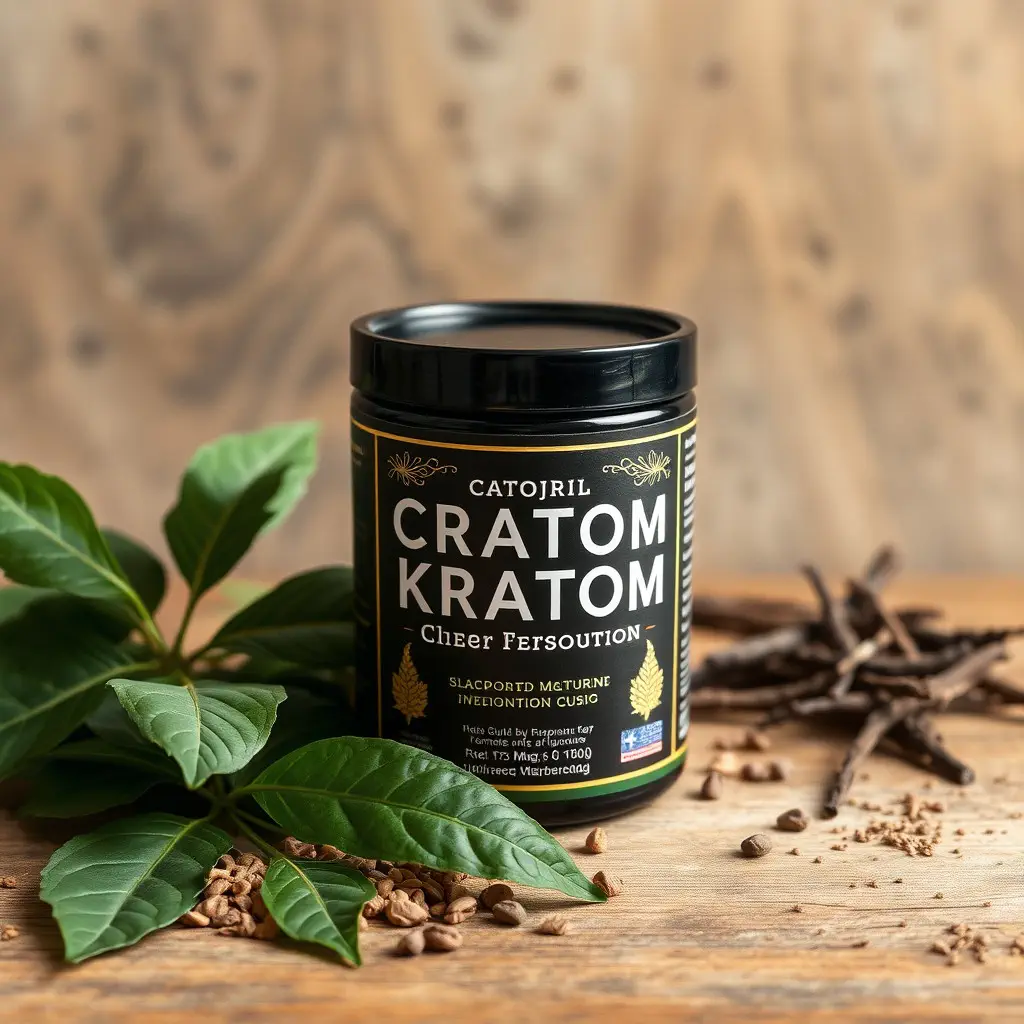Kratom, derived from Mitragyna speciosa leaves, is a natural supplement being explored by the fitness community for its potential to alleviate muscle soreness and support athletic performance. Its active components, mitragynine and 7-hydroxymitragynine, interact with opioid receptors to provide analgesic effects, helping athletes manage pain from intense exercise. Kratom's stimulant properties can also boost energy and mental focus, which are crucial for sustained physical effort. Different kratom strains offer a range of effects from energizing to calming, which can aid in regulating pace during endurance training and potentially reduce fatigue. The anti-inflammatory and analgesic qualities of kratom may also enhance muscle recovery post-exercise. However, it is essential to consult with healthcare professionals before using kratom due to its potent effects and potential interactions with other substances or health conditions. Kratom should be integrated into a fitness routine that includes proper nutrition, hydration, and rest, and its legal status must be considered. The use of kratom for muscle soreness relief is a topic of interest for those in endurance training, aiming to minimize discomfort and improve performance outcomes.
Exploring the intersection of athletic performance and natural supplementation, this article delves into the emerging role of kratom in endurance training. With a focus on muscle soreness relief with kratom, we uncover its potential benefits for athletes seeking to enhance their stamina and accelerate recovery. As we navigate the integration of kratom into rigorous training regimens, insights are provided on how this supplement can be leveraged to optimize performance and mitigate post-workout discomfort. Join us as we explore the science and practice behind using kratom for endurance athletes’ needs.
- Unraveling the Potential of Kratom for Enhanced Endurance Training and Muscle Soreness Relief
- Integrating Kratom into Your Endurance Training Regimen for Optimal Performance and Recovery
- Mitigating the Effects of Intense Exercise: How Kratom Can Alleviate Post-Workout Muscle Soreness
Unraveling the Potential of Kratom for Enhanced Endurance Training and Muscle Soreness Relief

Kratom, a botanical derived from the leaves of Mitragyna speciosa, has garnered attention in the fitness community for its potential ergogenic benefits. Research and anecdotal evidence suggest that certain strains of kratom may offer muscle soreness relief with kratom by modulating pain perception, thereby enhancing endurance training. The alkaloids present in kratom leaves, notably mitragynine and 7-hydroxymitragynine, interact with opioid receptors in the brain, which could contribute to analgesic effects that may alleviate muscle soreness following intense exercise sessions. This pain relief can be pivotal for athletes and fitness enthusiasts who engage in repetitive movements or high-impact activities, allowing them to push their limits without being hindered by discomfort.
Moreover, the stimulant properties of kratom may aid in endurance training by elevating energy levels and mental focus, which are crucial for sustained physical performance. The subtle balance of sedative and stimulating effects in different kratom strains can help users maintain a consistent pace during prolonged activities while also potentially reducing fatigue. The anti-inflammatory properties attributed to kratom may also play a role in muscle recovery, which is essential for continuous training regimens aimed at improving endurance. As such, integrating kratom into a fitness routine could be a multifaceted approach to enhance performance and accelerate recovery, offering relief from muscle soreness and promoting sustained physical activity. However, it is imperative to consult with healthcare professionals before incorporating kratom into any training regimen due to its potent effects and potential interactions with other substances or medical conditions.
Integrating Kratom into Your Endurance Training Regimen for Optimal Performance and Recovery

Integrating kratom into an endurance training regimen can be a strategic move for athletes seeking to enhance both performance and recovery. Kratom, derived from the leaves of Mitragyna speciosa, has been traditionally used in Southeast Asia for its stimulatory and analgesic properties. For those engaging in prolonged physical activities, kratom can serve as a multifaceted tool. Its alkaloids, such as 7-hydroxymitragynine and mitragynine, are known to influence the body’s response to pain and fatigue, potentially allowing for longer training sessions without the usual onset of muscle soreness.
When it comes to recovery, kratom may offer muscle soreness relief with its analgesic effects, which can be particularly beneficial after intense workouts or races. This relief from discomfort means that athletes can return to training more quickly, reducing downtime and improving overall performance over time. Additionally, kratom’s potential to alleviate pain might also help in maintaining a consistent training schedule, as it may reduce the need for rest due to soreness. However, it is crucial to approach its integration into one’s regimen with caution, adhering to recommended dosages and consulting with healthcare professionals to ensure safe usage, especially considering the individual’s unique physiology and any existing health conditions. Proper hydration, nutrition, and rest remain foundational to endurance training, with kratom serving as a complementary aid rather than a replacement for these essential components of a balanced training program.
Mitigating the Effects of Intense Exercise: How Kratom Can Alleviate Post-Workout Muscle Soreness

Engaging in endurance training often leads to muscle soreness, a common side effect of intense physical activity. The discomfort that follows can hinder recovery and diminish performance in subsequent workouts. Kratom, a natural supplement derived from the leaves of Mitragyna speciosa, has been recognized for its potential in mitigating post-exercise muscle soreness. Studies suggest that certain strains of kratom may interact with opioid receptors in the brain, producing analgesic effects that can alleviate pain associated with rigorous exercise. The alkaloids present in kratom, such as 7-hydroxymitragynine and mitraphylline, are believed to contribute to its pain-relieving properties. By incorporating kratom into a post-workout routine, athletes and fitness enthusiasts may experience significant muscle soreness relief with kratom, promoting faster recovery times and enhancing the overall endurance training experience. It is important to note that while kratom can be beneficial for muscle soreness, it should be used responsibly and in accordance with expert guidance, as dosage and strain selection are crucial factors in determining its efficacy and safety. Users should also be aware of the potential regulatory status of kratom in their jurisdiction before considering its use as part of an endurance training regimen.
Incorporating kratom into endurance training and recovery routines may offer significant benefits for athletes seeking muscle soreness relief and enhanced performance. The exploration of its potential, detailed in the sections discussing its role in enhancing endurance training and mitigating post-workout muscle soreness, suggests that kratom could be a valuable addition to an athlete’s regimen. However, it is crucial for individuals to consult with healthcare professionals before integrating kratom due to its potent effects. With responsible use and further scientific research, kratom may emerge as a promising tool for those looking to alleviate the rigors of intense exercise and maintain optimal physical condition.






